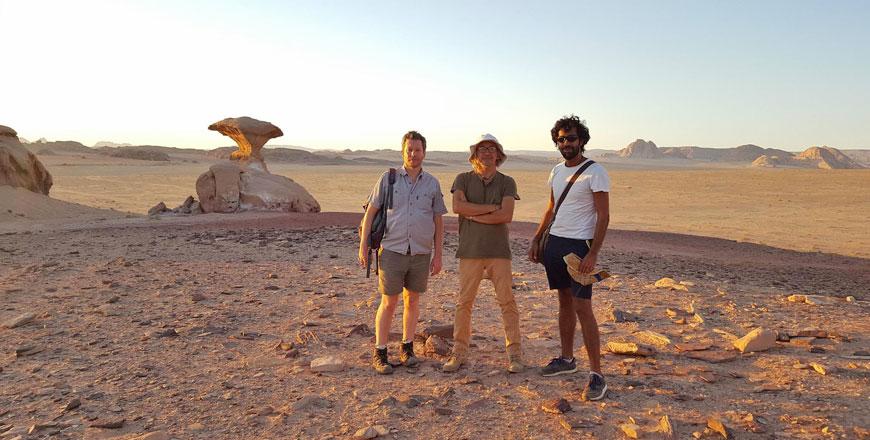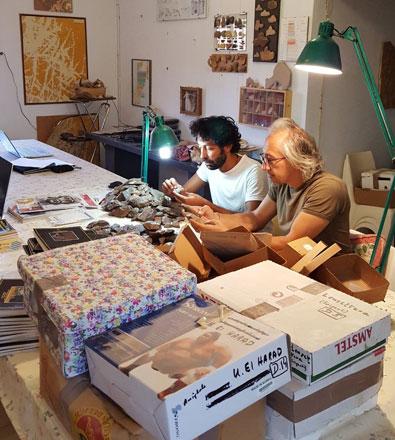You are here
Italian scholar highlights 'musealisation' efforts of Wadi Rum discoveries
By Saeb Rawashdeh - Oct 09,2018 - Last updated at Oct 15,2018

Luca Pollarolo(centre) in Wadi Rum where he is tasked to select the best stone tools from the collected Paleolithic objects (Photo courtesy of Luca Pollarolo)
AMMAN — In order to protect the rich cultural heritage of the Hishma Desert (Wadi Rum), two measures involving the local community are keys to success, experts said, citing the education of schoolchildren and the training of tour guides.
Schoolchildren should be taught the value of their own historic heritage while guides should be aware that visitors can destroy thousand-year -old inscriptions and engravings in the Hishma Basin (some 316km south of Amman) if they are not told to leave these ancient art intact, said anthropologist Luca Pollarolo at the recent presentation titled "Disi Stones: A Path of Bedouin Jordan”.
Organised at the Dante Alighieri Institute by the Italian embassy and the European National Institutes for Culture, the event saw the participation of Minister of Tourism and Antiquities Lina Annab, scholars and diplomats who listened to Pollarolo’s presentation on the Italian research in Disi.
The project, launched 40 years ago by Professor Edoardo Borzatti and his team from the University of Florence, succeeded in collecting and analysing thousands of objects from the Hishma Basin. Stone tools, anthropomorphic statues from the Chalcolithic period, graffiti representing humans, animals, hunting scenes and everyday life are currently preserved partly at the stores of Aqaba Special Economic Zone Authorities (ASEZA), and partly at the premises of Borzatti’s mission, near the site in Wadi Rum, according to the team.
“In 2004-2005, the infrastructural works for the building of the ‘Disi Museum’ by ASEZA began, as part of the already declared natural area, protected by the Jordanian government in 1998,” Pollarolo noted, adding that ASEZA had begun all the procedures for the restructuring and completion of the museum.
Pollarolo will lead a team of experts to identify the exhibition itinerary and classify the material available for the aim of “musealisation”. It will allow the Jordanian and international public to get acquainted with the millenary Bedouin civilisation “through the exhibits made accessible in the new museum”, the Italian scholar said, underlining that the project is going to be “a catalyst” for development of sustainable tourism in the Wadi Rum Desert.
Pollarolo's first field mission has already allowed the identification of the main operational needs and the formulation of a project for the completion of the museum in collaboration with The Jordan Museum, organisers said.
The completion of the museum in Disi, the items' reorganisation and the production of a digital mapping of the site are scheduled for the next year, Pollarolo noted.
“This museum will also cover ethnography and natural sciences,” Pollarolo stressed, adding that a huge task lies ahead of the team that has to choose the best stone tools from the abundance of collected objects.
Related Articles
AMMAN — Thousands of findings uncovered over the past 40 years through the Italian archaeological mission to the Hisma Basin will be showcas
AMMAN — Italian Ambassador to Jordan Fabio Cassese, Acting Director General of the Department of Antiquities Ahmad Juma’a Alshami, and Deput
Aqaba Special Economic Zone Authority (ASEZA) Chief Commissioner Hani Mulki on Monday launched a new marketing plan to develop the Red Sea resort’s tourism sector.

















